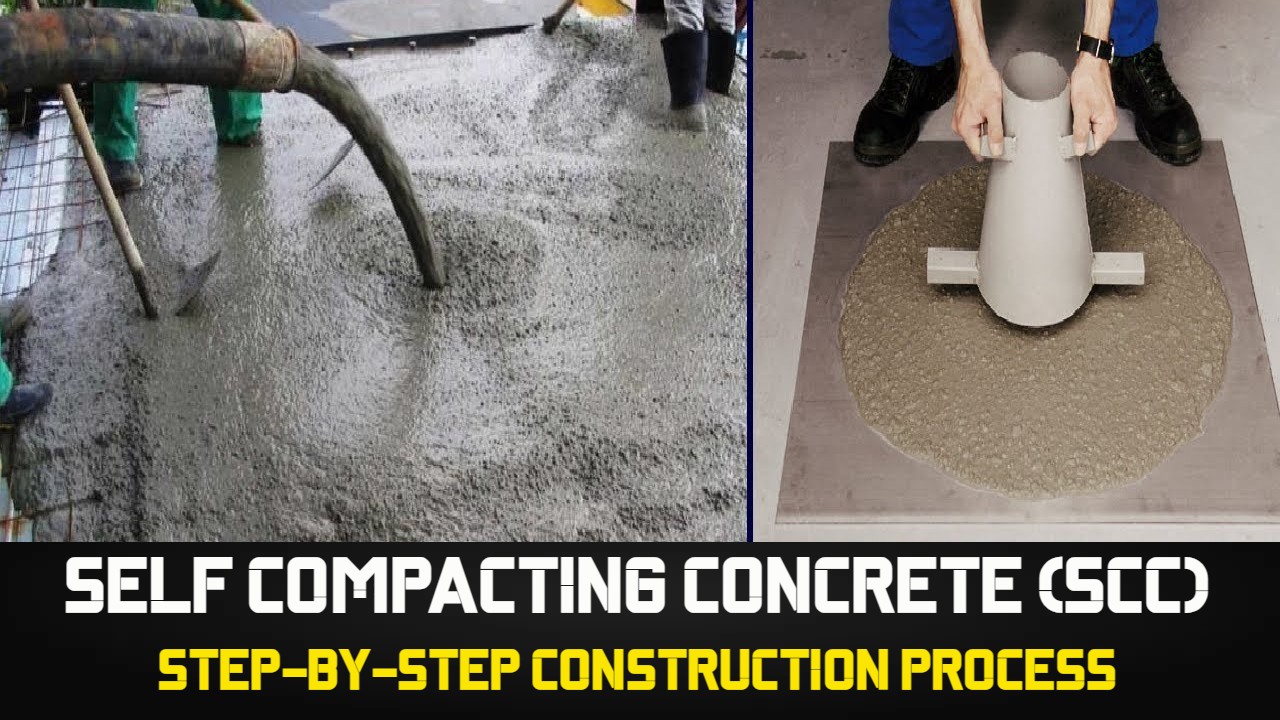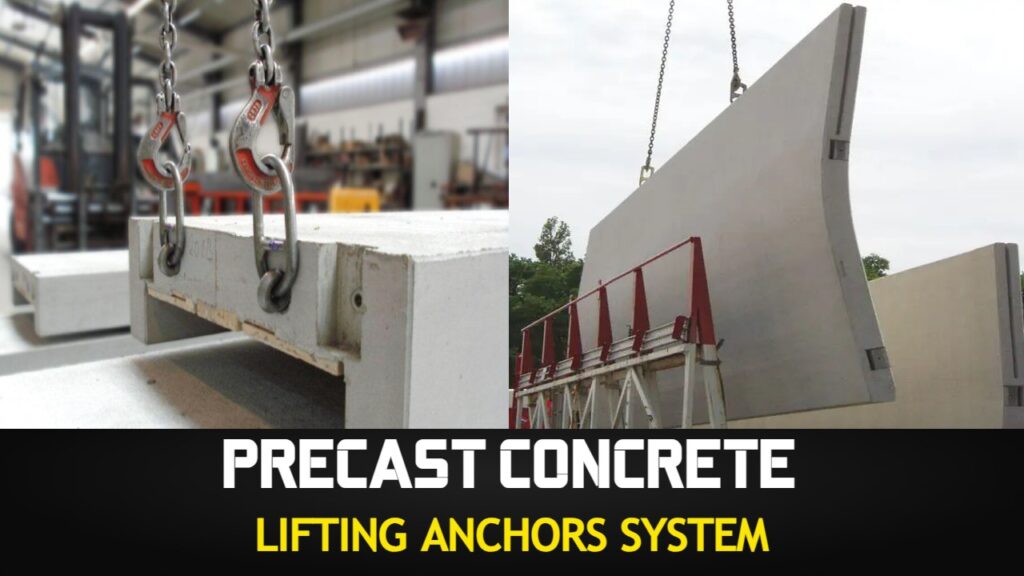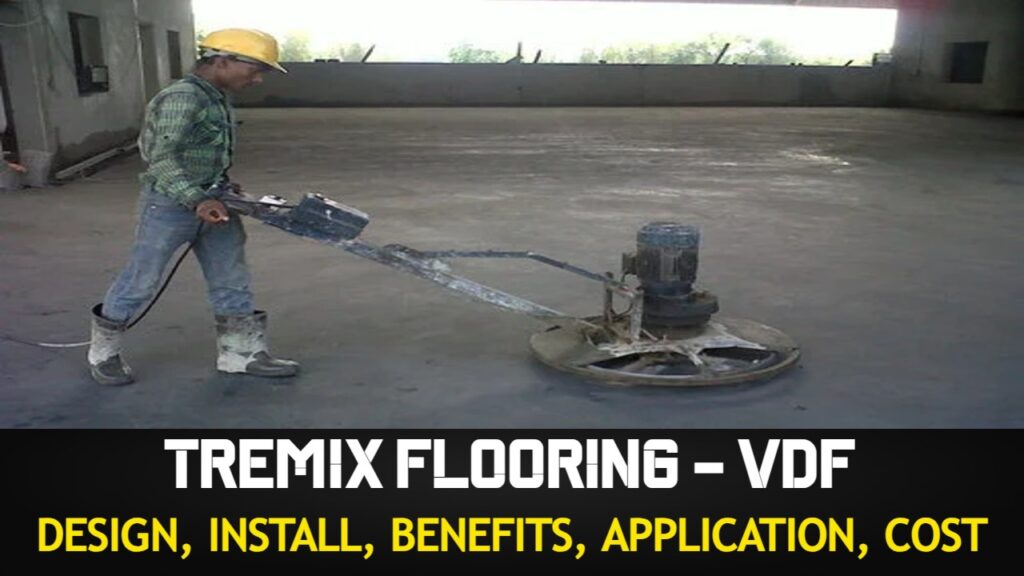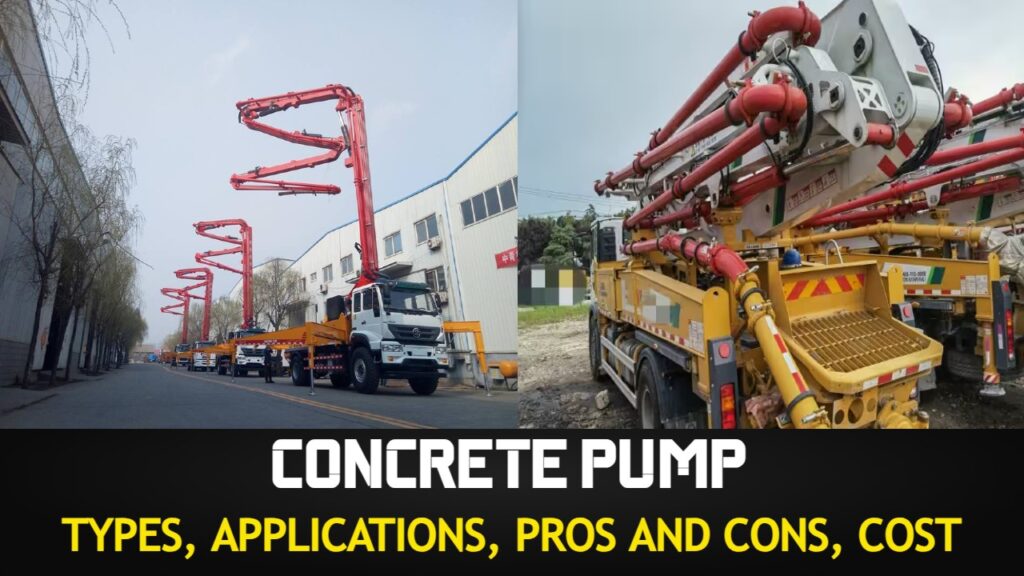Innovative tools and methods are constantly being developed in the field of contemporary building to streamline procedures and boost effectiveness. Self Compacting Concrete (SCC), a cutting-edge variation of conventional concrete that has the power to completely alter the building industry, is one such ground-breaking substance. Self Compacting Concrete (SCC) is a type of concrete that is particularly designed to flow smoothly and uniformly into even the most complicated and crowded locations without the need for mechanical consolidation. This article goes into the realm of self-compacting concrete, examining its elements, advantages, uses, and effects on the environment.
Contents
- 1 What Is Self Compacting Concrete?
- 2 Composition and Raw Materials of SCC
- 3 The Science Behind Self Compacting Concrete (SCC)
- 4 Properties of Self-compacting Concrete
- 5 Applications of Self Compacting Concrete
- 6 Advantages of Self Compacting Concrete (SCC)
- 7 Limitations of Self Compacting Concrete (SCC)
- 8 Environmental Impact of SCC
- 9 Maintenance and Durability of SCC
- 10 SCC vs. Conventional Concrete
- 11 Future Trends in SCC Technology
- 12 Self Compacting Concrete PPT (SCC)
- 13 Conclusion
- 14 Frequently Asked Questions (FAQs)
What Is Self Compacting Concrete?
Self Compacting Concrete (SCC) is a unique variety of concrete that has the ability to fill and distribute uniformly within formwork without the need for external consolidation. It also has exceptional flow and self-leveling capabilities. Self Compacting Concrete (SCC) produces compaction only via its own weight, in contrast to traditional concrete, which requires physical shaking or compaction to eliminate air spaces and assure correct distribution.
Self Compacting Concrete (SCC) is designed to flow easily through complicated geometries and highly reinforced sections because of its great flowability. By carefully planning the mix proportions and adding chemical admixtures, superplasticizers, and stabilizers, this extraordinary fluidity is accomplished. These additives make concrete more workable and stable even when exposed to gravity’s effects by reducing the viscosity of the material.
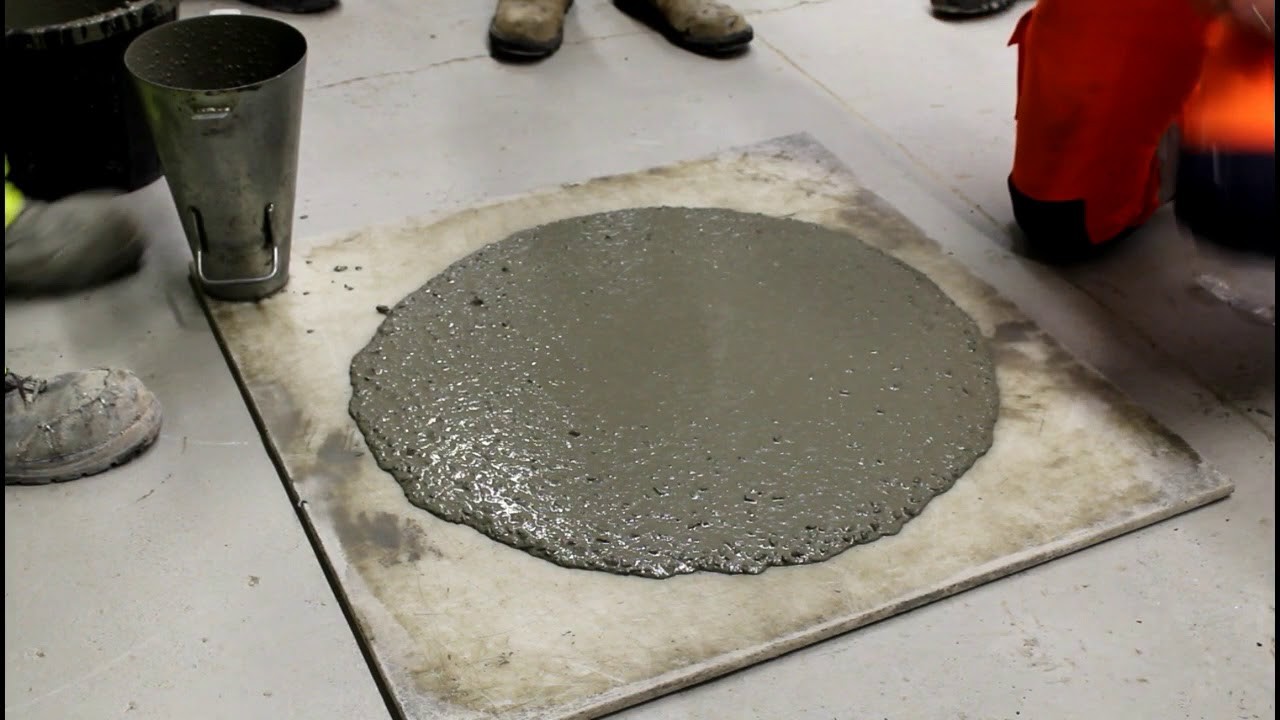
The idea of self-compacting concrete was initially developed in Japan in the late 1980s to address construction issues including intricate architectural components and substantially reinforced structures. Due to its many benefits, Self Compacting Concrete (SCC) has now become widely accepted and used in the building industry worldwide.
Also Read: Self Compacting Concrete (SCC): Uses, Benefits, Materials Required, PPT
Composition and Raw Materials of SCC
Self Compacting Concrete (SCC) is made of precisely chosen ingredients to provide its distinctive flow and self-leveling qualities. For SCC to work at its best during construction, a well-balanced mixture of raw materials and chemical additives is necessary. The following are the main elements of SCC:
Cementitious Materials
In Self Compacting Concrete, cement serves as the binding agent and offers the required strength and durability. The primary cementitious ingredient is typically Portland cement. However, additional cementitious materials (SCMs) can also be used. Examples of SCMs are fly ash, silica fume, and ground granulated blast furnace slag (GGBS). Improved sustainability results from SCMs since they improve the characteristics of SCC and lower the overall cement content.
Aggregates
In order for Self Compacting Concrete (SCC) to have volume and stability, aggregates are crucial. The choice of aggregates is determined by the requirements of the particular project. To produce the desired concrete properties, fine aggregates (sand) and coarse aggregates (gravel or crushed stone) are blended. The workability and segregation resistance of SCC are influenced by the shape, grading, and surface roughness of aggregates.
Water
The hydration of cement, which results in the hardening of concrete, requires water. Self Compacting Concrete (SCC) mixes carefully manage the water content to provide the necessary flowability without sacrificing strength and durability.
Chemical Admixtures
Chemical additives are essential for improving the flowability and self-compacting properties of SCC. The most popular admixtures used in Self Compacting Concrete (SCC) are superplasticizers. They scatter cement particles, lowering the paste’s surface tension and promoting more fluidity. To adjust the rheological characteristics of SCC, stabilizers and chemicals that affect viscosity are occasionally additionally included.
Mineral Admixtures
Other mineral admixtures, such as metakaolin, rice husk ash, or limestone powder, can be added in addition to SCMs to enhance the characteristics of Self Compacting Concrete. These additions can make concrete easier to work with, less permeable, and more durable overall.
The percentage of these basic components in the mix design has a significant impact on the ultimate qualities of SCC, including flowability and stability. The proper balance must be struck in order to avoid problems like excessive bleeding, segregation, or early setting. To fulfill the unique requirements of any building project, mix designs are often produced through laboratory testing and optimization.
Self Compacting Concrete (SCC) is made up of a well balanced mixture of cementitious substances, aggregates, water, and chemical admixtures. Self Compacting Concrete can flow easily, fill formwork equally, and achieve high stability without the requirement for external vibration or compaction because to the perfect mix design and the addition of additives. Modern building methods are being revolutionized by properly engineered SCC compositions, which provide effective and long-lasting concrete structures.
Also Read: Top 250 Civil Engineering Interview QnA : PDF Download
The Science Behind Self Compacting Concrete (SCC)
Self Compacting Concrete’s (SCC) peculiar behavior is a result of its rheological characteristics. Self Compacting Concrete has higher viscosity and lower yield stress than ordinary concrete, enabling it to flow easily under weight. These qualities control the concrete’s capacity to self-level and distribute uniformly inside the formwork. To customize the mix design in accordance with particular building needs, it is essential to comprehend the physics behind self-compacting concrete.
Properties of Self-compacting Concrete
Self Compacting Concrete (SCC) differs from traditional concrete in that it has a number of unique characteristics. Its placement simplicity, higher structural performance, and increased construction efficiency are all influenced by these features. Self-compacting concrete’s (SCC) main characteristics include some of the following:

Flowability
Self Compacting Concrete (SCC) has an extraordinary flowability that enables it to spread and fill the formwork smoothly while bearing weight. Without the requirement for external vibration, the concrete may easily flow around crowded reinforcing and through complex forms to ensure optimum compaction.
Self-Leveling
Self Compacting Concrete (SCC) has the ability to self-level, thus no extra compaction work is required to keep the surface level. This characteristic guarantees that the concrete surface stays level and even, lowering the possibility of surface flaws.
Coarse Aggregate Segregation Resistance
In particular, the segregation of the coarse particles is minimized in Self Compacting Concrete (SCC), which is a concrete that compacts itself. The homogeneity and structural integrity of the concrete are enhanced by the evenly distributed particles throughout the mix.
High Filling Capacity
A full and solid concrete construction is ensured by SCC’s high filling capacity, which enables it to fill even the smallest cavities and restricted locations. In locations with complicated geometries and strongly reinforced structures, this characteristic is very advantageous.
Stability and Homogeneity
Excellent stability makes Self Compacting Concrete (SCC) resistant to component segregation during transit and placement. Because of its uniformity, the concrete structure’s qualities are maintained throughout.
Reduced Bleeding
The separation of water from the cement paste, known as bleeding, is lessened by the formulation of self-compacting concrete (SCC). This characteristic aids in preserving the correct water-to-cement ratio and hinders the development of pores or cavities at the concrete’s surface.
Enhanced Workability
Due to SCC’s excellent workability, which makes it simple to handle and install, less manpower is needed during construction. It boosts construction productivity by enabling quicker pouring and setting of concrete.
Improved Durability
SCC’s long-term durability and resistance to cracking and other types of degradation are improved by its well-compacted and uniform structure. Its durability is influenced by the decreased permeability and strengthened connection between the cement matrix and particles.
High Strength
Due to its high compressive strength, Self Compacting Concrete (SCC) is appropriate for a variety of structural applications. The mixture’s high mechanical qualities are a result of an optimal mix design and effective compaction.
Sustainability
Because SCC uses supplemental cementitious materials (SCMs) more effectively and requires less vibration equipment, it is more sustainable. Reduced carbon footprint is another benefit of the possibility for decreased cement content.
Self Compacting Concrete (SCC) is a useful material in contemporary building because of a special set of qualities. Because of its flowability, self-leveling characteristics, and high filling capacity, it makes it easier to create durable, high-performance concrete structures. As it meets the needs of sustainability and efficiency, SCC continues to transform the building sector by offering answers to difficult construction problems.
Applications of Self Compacting Concrete
Self Compacting Concrete (SCC) offers a wide range of uses in different building projects because of its special qualities and benefits. It is the best option for projects where using conventional concrete placing techniques may be difficult or time-consuming due to its remarkable flowability and self-leveling characteristics. Here are a few of the main uses for SCC:
High-Rise Buildings
SCC is very useful when building towering structures with plenty of reinforcement. Without the aid of external vibration, appropriate compaction is ensured by its capacity to flow smoothly and uniformly around crowded reinforcement. This not only expedites the building process but also strengthens the building’s overall structure.
Bridge Construction
Bridges frequently feature complex geometry and sectional reinforcement. Even in locations where conventional concrete compaction techniques would be challenging or unfeasible, SCC’s self-compacting characteristic makes the installation procedure simpler. This benefit minimizes the amount of work and construction time needed while keeping the necessary strength and durability.
Tunnel Linings
Self Compacting Concrete (SCC) is preferred for lining purposes in tunnel construction. Due to its fluidity, it may fill the formwork quickly and effectively, resulting in a consistent lining that satisfies rigid structural requirements.
Precast Elements
SCC has gained popularity in the precast sector, where intricate designs and flawless finishing are crucial. SCC is a great option for creating architectural and ornamental precast features since it is simple to fill complex molds and achieve high-quality surface treatments.
Infrastructure Rehabilitation
In order to fill gaps and restore damaged concrete structures, SCC can be utilized in repair and rehabilitation operations. Due to its flow and self-leveling properties, it can reach regions that are challenging to access and improve bonding with pre-existing concrete and reinforcing components.
Architectural Concrete
SCC is a good choice for architectural concrete applications because of its consistent, smooth flow, where aesthetics are very important. SCC can produce visually beautiful surfaces with few flaws, improving the structure’s overall look.
Foundations and Footings
SCC is frequently used in the building of footings and foundations, particularly for structures with complicated or asymmetrical designs. Because of its self-compacting qualities, a solid and long-lasting foundation is ensured around reinforcement and formwork.
Underwater Concrete Placement
SCC is a good choice for underwater concrete laying because of its capacity to flow and retain stability without segregation. It is employed in a variety of maritime building projects, including pipelines, coastal defense, and submerged structures.
Mass Concrete Elements
Large concrete pour projects, such dams and substantial retaining walls, benefit from SCC. Because SCC is self-compacting, it guarantees that the concrete is dispersed uniformly, reducing the possibility of heat fractures and other flaws in large-scale concrete components.
Industrial Flooring
SCC offers important advantages in industrial environments where sizable floor expanses must be cast with few joints. Due to its self-leveling qualities, smooth and level surfaces may be achieved with less finishing work.
Due to its remarkable flowability, self-leveling capabilities, and increased construction efficiency, self-compacting concrete (SCC) has been used in a broad variety of modern building projects. SCC continues to change the construction industry, providing answers to difficult construction difficulties and producing long-lasting, beautiful structures, from high-rise skyscrapers to tunnel linings and architectural features.
Advantages of Self Compacting Concrete (SCC)
Self Compacting Concrete (SCC) is a game-changer in the construction sector thanks to its many benefits. Its distinct qualities and traits distinguish it from traditional concrete and revolutionize the planning and building of buildings and other structures. Some of the main benefits of self-compacting concrete (SCC) are listed below:
Ease of Placement
SCC’s remarkable flowability and self-leveling characteristics are among its most important benefits. Without the requirement for external consolidation, SCC can fill complicated and crowded formwork with ease during installation. This feature streamlines the building process, lowers the amount of manpower needed, and expedites project completion.
Improved Construction Efficiency
The simplicity of location results in more effective construction. Construction cycles may go more quickly because to SCC’s considerable reduction in the time needed for concrete pouring and compaction. On building sites, this may lead to cost savings and better productivity.
Enhanced Quality and Homogeneity
SCC has characteristics that are constant and uniform across the whole structure. Because concrete self-compacts, there is less chance of honeycombing and cavities because the concrete fills all gaps and crevices uniformly. The improved uniformity enhances the structure’s overall toughness and longevity.
Reduced Labor and Equipment Requirements
Concrete placing does not need vibration or compaction machinery when using self-compacting concrete (SCC). As a result, labor expenses related to conventional concrete laying techniques can be reduced, and less construction equipment is needed.
Improved Surface Finish
Without the use of additional surface treatments, SCC may provide a surface finish that is smooth and visually acceptable. It is great for architectural features because of this benefit since a high-quality surface look is crucial.
Enhanced Structural Performance
Self-compacting concrete is an ideal choice for numerous structural applications because of its strength and endurance. It has the capacity to support large loads, endure cracking, and preserve structural integrity over time.
Better Reinforcement Encasement
Better encasing is ensured by the ease with which SCC flows around and between reinforcing bars. As a result, the bond strength between the concrete and reinforcement is increased, improving the structural performance as a whole.
Reduced Noise and Vibration
Construction sites are quieter and more pleasant when there is no external vibration during concrete laying. Particularly favorable are metropolitan settings or building sites close to residences for reduced noise pollution.
Sustainable Construction Practice
SCC frequently calls for less cement than traditional concrete, which lowers its carbon impact. More sustainable building techniques are made possible by the effective use of raw resources and the possibility for increased structural lifespan.
Versatility in Design and Application
The features of SCC can be modified to fit certain project needs. It may be applied to a variety of construction projects, such as high-rise structures, bridges, tunnels, and precast components.
In conclusion, Self Compacting Concrete (SCC) is a desirable option for contemporary building projects due to its benefits. Its flowability, homogeneity, and improved structural performance not only make building easier, but also make constructions more long-lasting and sustainable. SCC continues to be at the forefront of developments in concrete technology as the construction industry adopts cutting-edge materials and methods.
Limitations of Self Compacting Concrete (SCC)
Self Compacting Concrete (SCC) has a lot of benefits, but it’s also important to understand its drawbacks and difficulties. SCC has several limitations, just like any other building material, that must be taken into account when choosing it for a given project. These are some of the SCC’s drawbacks:
Cost
SCC could be more expensive at first than traditional concrete. The total cost of the mix design may rise with the use of specialty materials and chemical admixtures. Cost reductions can, however, be made by using less manpower and equipment while placing the object.
Mix Design Sensitivity
Precise mix design and thoughtful raw material selection are necessary to produce SCC with the right characteristics. Its efficacy can be considerably impacted by minor changes in the mix proportions or the quality of the components, making adequate quality control essential.
Setting Time
Comparing SCC to ordinary concrete, the setting time of SCC may be longer. While this may be helpful while placing, it may also need adjusting building timelines to account for the prolonged setting period.
Risk of Segregation
If not treated appropriately after insertion, the high flowability of SCC might increase the likelihood of segregation. The distribution of aggregates and cement paste may not be uniform due to segregation, which might cause structural flaws.
Formwork Pressure
SCC’s high fluidity can put strain on formwork during installation, especially when it comes to vertical structures like walls and columns. To prevent formwork failure, adequate support and bracing are necessary.
Casting Large Elements
It might be difficult to pour a lot of SCC in one location because of how self-leveling it is. To guarantee uniform flow and effective consolidation, careful planning and coordination are required.
Compatibility with Reinforcement
SCC’s excellent flowability might present problems in portions that have a lot of reinforcement. To guarantee complete encasing and effective bonding with reinforcement, the concrete must be properly planned and laid.
Risk of Bleeding and Segregation
SCC may experience bleeding, or the separation of water from the mixture, under specific circumstances. Additionally, the SCC may segregate if the mix design is not appropriately adjusted, resulting in non-uniformity in the finished product.
Sensitive to Temperature Changes
SCC is susceptible to temperature variations that occur during mixing, transportation, and installation. To prevent any negative impacts on the qualities of the concrete, appropriate steps must be made to regulate its temperature.
Inadequate Quality Control
Strict quality control procedures are required throughout manufacture and deployment in order to effectively capitalize on the advantages of SCC. Inadequate quality control can result in differences in the characteristics of the concrete, which could have an impact on the structure’s long-term performance.
Despite these restrictions, improvements in mix designs and SCC technology continue to tackle many of these issues. SCC remains a potential material for different building applications, enabling increased efficiency, durability, and sustainability, by being aware of and minimizing these limits. Maximizing the benefits of SCC while avoiding its drawbacks requires careful planning, quality control, and expert execution.
Environmental Impact of SCC
The environmental effect of building materials is a critical factor in the era of sustainable development. SCC is in line with the sustainability tenets since, as compared to traditional concrete, it often has a lower carbon footprint during manufacture. A more environmentally friendly construction process is made possible by the reduced cement content and effective utilization of raw resources. The lengthy service life of SCC-built structures also prevents the need for frequent replacements and the resulting resource usage.
Maintenance and Durability of SCC
Any building material must have long-term functionality and upkeep. SCC has outstanding longevity, retaining its power and characteristics over time. SCC buildings that have been well planned and built need less maintenance, which reduces costs over time. SCC’s special qualities might offer difficulties when repairs or rehabilitation are required, thus it’s important to use the right repair techniques.
SCC vs. Conventional Concrete
SCC and regular concrete may be compared to reveal the advantages and disadvantages of each. SCC differs from traditional concrete, which needs external consolidation operations because of its capacity to flow and self-level. This distinction speeds up building, especially in crowded regions, and reduces labor and equipment costs. SCC may have difficulties with various building techniques, like as pumping and casting big quantities. To utilize SCC to its fullest capacity in a variety of projects, careful planning and coordination are required.
Future Trends in SCC Technology
The field of SCC is no exception to technology’s ongoing evolution. To enhance the characteristics and scope of applications of SCC, scientists and engineers are looking into new directions. The inclusion of nanotechnology has the potential to improve the compressive and flexural strengths of SCC. Future applications of SCC will be more adaptable thanks to the development of improved mix designs that will address particular project needs.
Self Compacting Concrete PPT (SCC)
Conclusion
Inherently Compact Concrete has changed the way that building is done. Its flowability, self-leveling capabilities, and strength have created new design and building opportunities for intricate structures. SCC is at the forefront of cutting-edge materials that satisfy these requirements as the building industry embraces sustainability and efficiency. SCC is poised to influence the future of construction by improving mix designs, upholding quality control procedures, and investigating new technologies. This will make it more effective, sustainable, and adaptive.
Frequently Asked Questions (FAQs)
What is the cost difference between SCC and conventional concrete?
Due to the use of chemical admixtures, the initial cost of SCC could be a little higher. However, in some projects, the possibility of labor and time savings might make up for this expense.
Can SCC be used in cold weather conditions?
Yes, Cold weather usage of SCC is possible. To guarantee that the concrete retains the necessary temperature during placing and curing, however, precautions should be taken.
Is SCC suitable for architectural finishes?
Yes, SCC can provide high-quality surface finishes that are smooth and uniform, making it appropriate for architectural features where aesthetics are important.
How does SCC impact construction schedules?
Construction timelines are accelerated by SCC’s self-compacting characteristic because it doesn’t require external consolidation. This can result in a quicker project completion.
Are there any limitations to the size of SCC pours?
Even though SCC is very adaptable, bigger pours can need extra coordination and planning to guarantee a steady flow. Successful implementation depends on careful preparation.
